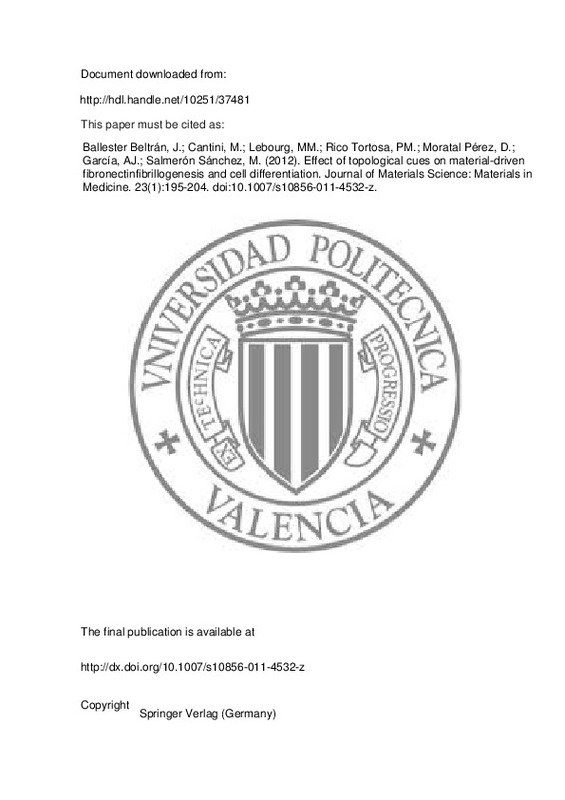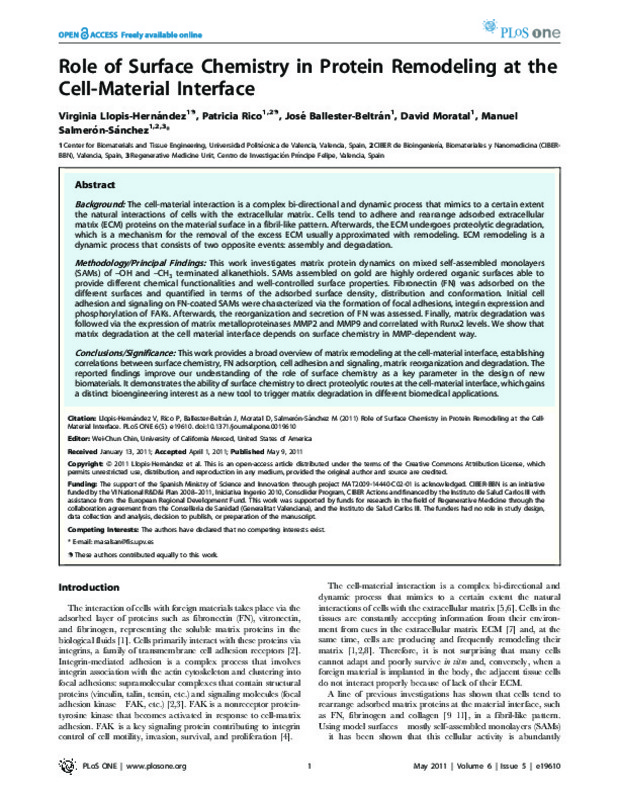

Listar por palabra clave "Fibronectins"
RiuNet: Repositorio Institucional de la Universidad Politécnica de Valencia
- RiuNet repositorio UPV
- :
- Listar por palabra clave
JavaScript is disabled for your browser. Some features of this site may not work without it.
Buscar en RiuNet
Listar
Mi cuenta
Ayuda RiuNet
Admin. UPV
Listar por palabra clave "Fibronectins"
Mostrando ítems 1-5 de 5
-
Ballester Beltrán, José; Cantini, Marco; Lebourg, Myriam Madeleine; Rico Tortosa, Patricia María; Moratal Pérez, David; García, Andrés J.; Salmerón Sánchez, Manuel (Springer Verlag (Germany), 2012-01)[EN] Fibronectin (FN) assembles into fibrillar networks by cells through an integrin-dependent mechanism. We have recently shown that simple FN adsorption onto poly(ethyl acrylate) surfaces (PEA), but not control polymer ...
-
Perez Garnes, Manuel; González García, Cristina; Moratal Pérez, David; Rico Tortosa, Patricia María; Salmerón Sánchez, Manuel (Wichtig Editore, 2011-02-04)[EN] Purpose: It is known that surface nanotopography influences cell adhesion and differentiation. Our aim is to analyze the effect of nanoscale topography on fibronectin adsorption and, afterwards, on cell adhesion in ...
-
Mukhatyar, Vivek J.; Salmerón Sánchez, Manuel; Rudra, Soumon; Mukhopadaya, Shoumit; Barker, Thomas H.; Garcia, Andres J.; Bellamkonda, Ravi V. (Elsevier, 2011)Bridging of long peripheral nerve gaps remains a significant clinical challenge. Electrospun nanofibers have been used to direct and enhance neurite extension in vitro and in vivo. While it is well established that oriented ...
-
Salmerón Sánchez, Manuel; Rico Tortosa, Patricia María; Moratal Pérez, David; Lee, Ted T.; Schwarzbauer, Jean E.; Garcia, Andres J. (Elsevier, 2011)Fibronectin (FN) is a ubiquitous extracellular matrix protein (ECM) protein that is organized into fibrillar networks by cells through an integrin-mediated process that involves contractile forces. This assembly allows for ...
-
Llopis Hernández, Virginia; Rico Tortosa, Patricia María; Ballester Beltrán, José; Moratal Pérez, David; Salmerón Sánchez, Manuel (Public Library of Science, 2011)Background: The cell-material interaction is a complex bi-directional and dynamic process that mimics to a certain extent the natural interactions of cells with the extracellular matrix. Cells tend to adhere and rearrange ...
Mostrando ítems 1-5 de 5

Universitat Politècnica de València. Unidad de Documentación Científica de la Biblioteca (+34) 96 387 70 85 · RiuNet@bib.upv.es





